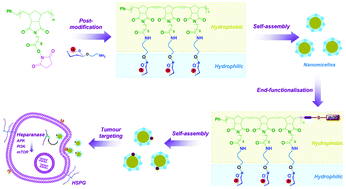End-functionalised glycopolymers as glycosaminoglycan mimetics inhibit HeLa cell proliferation†
Abstract
The glycosaminoglycans (GAGs) on cell surfaces play significant roles during cancer development, and the heparanase activity is strongly implicated in the structural remodeling of the extracellular GAG matrix, potentially leading to tumour cell invasion. Polymer–protein/peptide conjugates are one of the most promising approaches for anticancer therapy due to their controllability, biocompatibility, and targeting properties. In this study, distinct and well-defined glycopolymer–peptide conjugates, mimicking the multivalent architecture found in GAGs, were synthesised for targeting and killing tumour cells. Regio-selectively sulphated galactosamine derivatives were chemically synthesised, and six GAGs-mimetic glycopolymers were generated by post-modification based on the ring-opening metathesis polymerization (ROMP). The glycopolymers with diverse galactosamine sulphation patterns showed significant inhibitory effects on heparanase. Glycopolymers decorated with 3,4,6-O-sulphated GalNAc exhibited the highest activities, inhibiting heparanase as well as tumour cell proliferation. We demonstrated that a novel glycopeptide mimetic, derived from end-functionalised conjugation of the iRGD peptide on the glycopolymer, could effectively enter HeLa cells and inhibit signalling pathways involved in tumour cell proliferation. These findings should promote the development of novel glycomimetics for specific tumour-targeted therapies.



 Please wait while we load your content...
Please wait while we load your content...